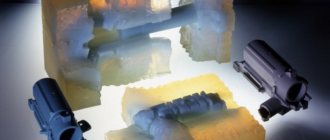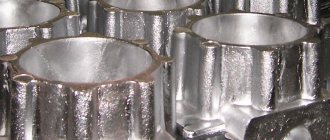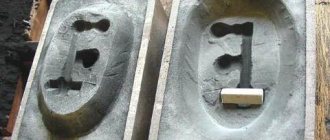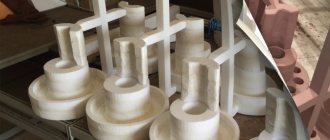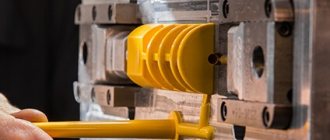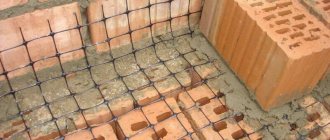- home
- >
- Library
- >
- Special casting methods
This technology can be classified as a group of methods for producing castings in one-piece molds using a one-time model, such as lost-wax casting (see lecture 2). But unlike previously discussed similar methods, the model is removed (gasified) not before pouring, but during the process of filling the mold with metal, which, replacing the evaporating model, occupies the free space in the mold cavity. Modern variants of the technological process are as follows.
One-time polystyrene foam models are made either by filling special metal molds (mass and large-scale production) with suspended polystyrene in the form of foamed granules, or by mechanical processing of normalized polystyrene foam boards (small-scale, single production). Complex models are made in parts. The individual parts and the gating system are connected into a single block by gluing or welding. The assembled model is painted with a layer of fireproof paint and air dried. The result is a fireproof, gas-permeable shell, firmly connected to the polystyrene foam model (Figure 7.1, a).
The finished model is installed in a special flask-container, filled with granular refractory filler without a binder, compacted by vibration, closed with a metal lid with holes, loaded and the sprue bowl is installed (Figure 7.1b).
Figure 7.1
– Scheme for manufacturing a casting using a gasified model: a – polystyrene foam model of the casting; b – mold prepared for pouring; c – mold filling, model gasification; d – casting with gating system elements
When making complex castings, after supplying the support material, the container is closed on top with plastic film, as in vacuum molding. To reduce the likelihood of mold destruction, a vacuum of up to 0.04 - 0.05 MPa is created in it. In the production of large massive castings, conventional cold-hardening liquid or bulk molding mixtures are used.
The prepared mold is filled with liquid metal (Figure 7.1, c). The gasification temperature of expanded polystyrene is close to 560°C, therefore, under the influence of the heat of the poured melt, the model is gasified. In this case, the mold cavity is gradually emptied and filled with metal.
After the casting has solidified and cooled, the mold-container is turned over, the filler is separated from the casting and poured out, after which the casting is sent for finishing operations (Figure 7.1, d). In the case of using conventional molding sands, the shape is knocked out on knockout grids.
The main feature of the method (the use of a one-piece mold) determines its main advantage for the quality of finished castings - increasing the accuracy of castings due to a reduction in the number of mold parts, cores, and, consequently, possible distortions in the configuration and dimensions of the castings associated with the manufacture and assembly of these mold elements. The accuracy of castings when casting using gasified models in sand molds without and with a binder according to GOST 26645-85 (amendment No. 1, 1989) corresponds to the accuracy of castings obtained in a mold or in a lined mold with cores.
Currently, gasification casting is most often used for the following purposes:
- production of medium and large massive castings in pilot and small-scale production;
- production of complex castings from ferrous and non-ferrous alloys weighing up to 50 kg with increased dimensional accuracy in serial and large-scale production. Such castings include, for example, a “cylinder block” type casting for a car engine.
Model materials
The material for the manufacture of gasified models is foaming polystyrene, which is a synthetic polymer product of the suspension polymerization of styrene in the presence of an emulsifier, stabilizer and blowing agent. Isopentane is most often used as a blowing agent. Expandable polystyrene granules used for making models are translucent or white opaque balls with a diameter of up to 3.2 mm with an outer hard polystyrene shell, inside of which there is a liquid phase - isopentane. The thinner the walls of the model, the smaller the expanded polystyrene granules should be. When heated to 27.9°C, isopentane boils and turns into gas with an increase in volume, and at 80–90°C the polystyrene shell softens and deforms under the influence of gas pressure. In this case, the volume of granules increases by 10–40 times. This process is called "foaming polystyrene beads." When foaming granules in a closed volume, they are sintered into a monolithic mass that accurately reproduces the configuration of the structure limiting its growth.
To produce castings using gasified models, polystyrene foam must have the following properties:
- with a density of 20 - 30 kg/m3, have sufficient technological strength (0.1 - 0.2 MPa) to maintain the dimensions and configuration of models during their manufacture, storage, transportation and molding;
- at all stages of the technological process have minimal and stable shrinkage (0.15 - 0.2%);
- have a sufficient gasification rate so that the metal being poured has time to fill the mold cavity before it begins to solidify;
- during gasification, decompose with a minimum content of coke-forming products in order to avoid blockages in castings.
The procedure for manufacturing parts by LGM casting
- Initially, a model of the future part is made, it is glued together, and a non-stick coating is applied on top;
- Next, the flask is molded; sand is usually used for this purpose;
- After that, hot metal is poured into the finished mold;
- The finished casting is subsequently cooled. Cooling methods today exist in different variations;
- Once the casting has cooled, it must be cut off from the gating system;
- Next you need to burn it;
- At the end of the entire process, the finished part is cleaned of paint and burnt marks.
Manufacturing of gasified models
The process of obtaining models in mass and large-scale production consists of two stages: preliminary foaming of the initial granules of expandable polystyrene in a free state and final foaming of the granules in a closed cavity of the mold - obtaining the model.
Pre-heat treatment
foaming polystyrene is necessary to obtain a subsequently gasified model with a given volumetric mass (density), which determines the strength of the model and the quality of the surface. The foaming ability of granules of a given dispersion is determined by the temperature and time of heat treatment (Figure 7.2).
Figure 7.2
– Increase in the volume of polystyrene foam granules (V) depending on temperature (numbers near the curves) and duration of foaming (t): solid lines – initial granule size 2.5 mm; dotted – 1.5 mm
With an increase in the duration of heat treatment, the volume of the granules increases and, accordingly, the bulk density of the foamed granules decreases. Increasing the processing temperature leads to a reduction in the time at which the granules reach their maximum volume. But at temperatures above 95°C the process becomes unstable and overexposure of the granules leads to loss of activity and shrinkage. This is due to an increase in the rate of deformation of the polystyrene shell of the granules with increasing temperature, as a result of which the walls of individual cells of the granules are destroyed and the loss of porogen occurs.
In enterprises with a small production volume, it is advisable to carry out preliminary foaming in hot water. To do this, the original polystyrene granules are placed in water at a temperature of 95 - 100 ° C and kept for 1 - 10 minutes with constant stirring to ensure uniform heat treatment and prevent the granules from sticking together. After the period of time necessary to foam the granules to a given bulk mass, they are removed and placed on racks with a mesh bottom for drying and exposure to air.
To heat the granules during pre-foaming, steam and high-frequency currents are also used. In large-scale and mass production conditions, superheated steam is most often used.
After preliminary foaming, the granules are kept in air for 6 hours to 2 days. During this period, the shell of the granules, cooling, again transforms into a glassy solid state, and isopentane vapor condenses, which leads to the appearance of a vacuum in the granules. During the holding process, air diffuses into the granules and the pressure equalizes. To reduce the holding time of foamed granules, you can use their holding at a pressure increased to 0.2 - 0.3 MPa.
Advantages of cast iron
Iron casting differs from castings from other materials in a number of advantages, such as:
- cheapness
- high strength and wear resistance
- high surface quality, minimizing subsequent machining
Characteristics and application of cast iron
It is important to note that when using modern casting methods, not only the casting itself is cheaper, but also the final product. Many industries, which at the end of the 20th century replaced the cast iron parts of their products with steel ones, have returned or are planning to return to the time-tested material at a new stage of its development
Making models in molds
The process involves reheating foamed and activated polystyrene granules placed in a mold, as a result of which they finally foam and sinter together, forming a polystyrene foam casting model.
The prepared granules are poured or blown with compressed air into the working cavity of the mold lubricated with a special lubricant so that they completely fill its volume. Lubricants are: a solution of synthetic heat-resistant rubber, silicone liquid, glycerin.
It is advisable to heat granules in large-scale and mass production using the so-called “thermal shock” method: superheated steam with a temperature of 125 - 135 ° C under a pressure of 0.2 - 0.35 MPa is fed directly into a mold filled with polystyrene granules. Passing between the granules, a turbulent steam flow intensively displaces the air in the pores of the filling and uniformly heats the polymer material throughout the entire volume, which finally foams. The resulting condensate, under the action of expanding granules, is pressed against the walls of the mold and removed through special drainage holes.
For small production volumes, simpler but less productive methods are often used:
- bath, when a mold with foamed granules is placed in a bath of water heated to a boil. At the end of the process, the mold is cooled in running water;
- autoclave, when a perforated mold filled with granules is placed in an autoclave, into which “hot” steam is supplied under a pressure of 0.13 - 0.145 MPa at a temperature of 105 - 115 ° C. Perforation of the mold in the form of holes in the walls with a diameter of 0.35 - 1.5 mm, or preferably slots with a width of 0.25 - 0.5 mm, serves to supply steam inside the mold, as well as to remove air and condensate during expansion and sintering of granules.
Lost wax casting
The essence of the process is as follows. Models or a link of models 2 are manufactured in a split mold 1, the working cavity of which has a casting configuration with allowances for shrinkage and cutting (Fig. 1 a).
Figure 1 - Sequence of manufacturing a multilayer shell mold using lost wax models : a – manufacturing the model; b – block assembly; c - immersion of the block in the liquid mixture; g – sprinkling; d – drying; e – model deletion; g – backfill; h – calcination; and – filling; 1 – mold; 2 – model; 3 – block of models; 4 – shell; 5 – fire-resistant material; 6 – air flow; 7 – water; 8 – filler; 9 – oven; 10 – calcined form
The model is made from materials that have a low melting point (wax, stearin, paraffin), capable of dissolving (urea) or burning without the formation of solid residues (polystyrene). Finished models or model links are assembled into blocks 3 (Fig. 1 b), including models of gating system elements made of the same material as the model. The block of models consists of links, the central part of which forms models of feeders and riser. Models of the bowl and the lower part of the riser are made separately and installed in the block during its assembly. A block of models is immersed in a container with a liquid molding mixture - a suspension for shell molds, consisting of dusty refractory material, such as quartz or electrocorundum, and a binder (Fig. 1 c). As a result, a thin (less than 1 mm) layer of suspension 4 is formed on the surface of the model. To strengthen this layer and increase its thickness, layers of refractory granular material 5 (fine quartz sand, electrocorundum, granular chamotte) are applied to it (Fig. 1d). The operations of applying the suspension and sprinkling are repeated until the required thickness of the shell is obtained on the model shell (3-10 layers).
Each layer of coating is dried in air or in ammonia vapor 6, which depends on the binder (Fig. 1e). After the shell mold has dried, the model is removed from it by melting, dissolving, burning or evaporation. Figure 1 e shows the process of removing the lost wax model in boiling water 7. This is how a multilayer shell mold is obtained using the lost wax model. To strengthen it before pouring, the shell mold is placed in a metal container and covered with refractory material 8 (quartz sand, fine scraps of used shell molds) (Fig. 1g).
To remove the remains of the models from the mold and strengthen the binder, the container with the shell mold is placed in oven 9 for calcination (Fig. 1 h). The mold is calcined at a temperature of 1223-12730 K. The calcined mold 10 is removed from the oven and filled with melt (Fig. 1 i). After the casting has solidified and cooled to a given temperature, the mold is knocked out, the castings are cleaned of ceramic residues, and the sprues are cut off from them.
In many cases, the shells are fired in a furnace before being filled with refractory material, and then they are backfilled with preheated refractory material to strengthen them. This allows
reduce the duration of calcination of the mold before pouring. The low roughness of the surface of the mold with sufficiently high fire resistance and chemical inertness of the material makes it possible to obtain castings with a high-quality surface.
After cleaning the castings from the remains of the shell mold, their surface roughness is characterized by a value of Rz = 40-10 µm, and in some cases reaches Ra = 2.5 µm.
No model and mold parting operations; the use of materials for the manufacture of models that make it possible not to disassemble the mold when removing the model; high fire resistance of mold materials; heating it to high temperatures before pouring - all this makes it possible to obtain castings of the most complex configuration, which are as close as possible to the configuration of the finished part from almost any alloy. The mass accuracy coefficient of castings can reach 0.85-0.95, which sharply reduces the volume of cutting processing and metal waste into chips. The accuracy of the castings corresponds to 8-11 qualifications, and the allowances for cutting processing for castings up to 50 mm in size are about 1.4 mm, and for castings up to
500 mm - about 3.5 mm. Therefore, lost wax casting is one of the progressive material- and labor-saving technological processes of metal processing.
Along with the advantages, the method has the following disadvantages:
- the mold manufacturing process is multi-operational, labor-intensive and lengthy;
- a large number of technological factors affecting the quality of the mold and casting, and, accordingly, the complexity of quality management;
- a large range of materials used to obtain the mold (materials for models, suspensions, block coating, support materials);
- the complexity of manipulative operations for making models and forms, and the automation of these operations;
- increased consumption of metal on gates and therefore low technological yield.
The indicated advantages and disadvantages determine the effective area of use of investment shell casting:
- production of castings that are as close in configuration as possible to the finished part in order to reduce the labor intensity of cutting metals and alloys; replacement of labor-intensive welding or soldering operations to increase the rigidity, tightness, and reliability of the structures of a part or assembly;
- production of thin-walled large-sized castings of increased precision in order to reduce the weight of the structure while increasing its strength, tightness and other operational properties;
- production of high-precision castings from alloys with special properties and structure.
The production of lost wax castings is widely used in various branches of mechanical engineering and instrument making.
The use of lost wax casting to produce blanks of machine parts instead of manufacturing them from forged blanks or rolled products allows, on average, to reduce metal waste into chips by 34-90%; reduce the labor intensity of cutting by 25-85%; the cost of manufacturing parts by 20-80%.
However, it should be taken into account that economic efficiency significantly depends on the choice of the range of castings produced by this method. Only with the correct selection of the range of parts can high economic efficiency of production be achieved.
Lost wax casting is widely used for the production of castings of complex configurations weighing from several grams to 10-15 kg. Various metals are used for lost wax casting: medium-carbon steels; structural alloy steels; carbon tool steels; casting corrosion-resistant and acid-resistant steels; heat-resistant steels and alloys; brass; bronze; silumins and other non-ferrous alloys.
Lost wax casting produces precision castings of turbine blades, valves, nozzles, and cutting tools.
The design of parts produced by investment casting has some features associated with the presence of a heated ceramic shell.
The casting wall thickness ratio should not exceed 4:1. To obtain an edge with a minimum thickness, a gradual reduction in the section thickness should be provided to avoid the appearance of cracks during cooling. Almost the minimum edge thickness can be taken as 0.3–0.4 mm; for parts operating at elevated temperatures, the permissible edge thickness should be at least 0.6–0.7 mm.
When lost wax casting, stiffeners are placed on the outer surfaces of the casting. The thickness of the stiffeners is taken to be 0.7–0.8 mm of the wall thickness.
Curvature radii can vary within wide limits. The minimum radius for the same wall thicknesses is usually 1–2 mm. If there is a significant difference in wall thicknesses, the radii of curvature are increased to 5–10 mm or more.
The holes can be through or blind. Through cast holes with a diameter d = 5 mm and a length l = (4...6)d are obtained without difficulty; holes with a diameter of less than 3 mm, as well as through
holes at d/l 0.5 are difficult to obtain. Minimum hole diameter d = 0.5 mm in walls 1 mm thick made of non-ferrous metals and in walls 1.5 mm thick made of other alloys.
Environmental Safety
In this process, there is no stench from burnt polymers, there are no fills along the mold connector (since there are no connectors) and there is no shifting of molds and cores during their assembly, because there are no cores themselves with all the shortcomings in their production and knockout.
Send your drawings or sketches to
Or call 8-800-250-88-72. Delivery throughout Russia and the CIS!!!
The production areas - molding, modeling, melting and refining - have approximately the same area and are equipped with simple equipment.
Due to the fact that the molds are in dry sand in a container that stands on a vibrating table to compact the sand for 2 minutes, there is also no need for high-precision molding machines for pressing and equipment for mounting the molds. The emphasis is on the production of very light models with a material density of about 26 kilograms per cubic meter. They are usually produced by women. We provide aluminum casting in Yekaterinburg and other cities of the Russian Federation.
For the production of large batches of castings, semi-automatic machines are used; the cycle for making models from foam plastic lasts about 3 minutes.
Using this method they make:
- iron castings,
- steel,
- bronze,
- brass,
- aluminum.
In the shape of a Christmas tree or bush, several castings can be produced at once, just like in jewelry production, with pinpoint precision. Almost all castings can be used without machining.
